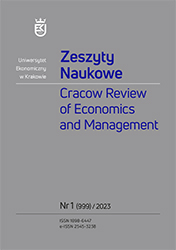On Reducing Occupational Fraud Risk in SMEs: Recommendations
DOI:
https://doi.org/10.15678/ZNUEK.2023.0999.0105Słowa kluczowe:
occupational fraud, employee abuse, occupational fraud risk, SMEs, risk reductionAbstrakt
Objective: To propose recommendations for SMEs interested in reducing the occupational fraud risk.
Research Design & Methods: The study is based on an analysis of the relevant literature, reports on fraud, the author’s own preliminary research, and an analysis of court case files pertaining to occupational fraud.
Findings: Occupational fraud in SMEs in Poland is largely detected by accident, as a result of a job rotation or changes in internal procedures, whereas the most popular detection method applied by enterprises in general are routine internal audits (as a global report on fraud indicates).
Implications / Recommendations: The risk of occupational fraud in the SME sector cannot be completely eliminated, but measures can be implemented to reduce its occurrence. These can be divided into soft measures (taking care of ethics at every juncture) and hard measures (facilitating the reporting of occupational fraud).
Contribution: The paper indicates ways of detecting occupational fraud in SMEs in Poland and, based on these observations, proposes recommendations for reducing the risk of occupational fraud in companies in this sector.
Pobrania
Bibliografia
Association of Certified Fraud Examiners (2018), Report to the Nations. 2018 Global Study on Occupational Fraud and Abuse, https://s3-us-west-2.amazonaws.com/acfepublic/2018-report-to-the-nations.pdf (accessed: 25.02.2019).
Association of Certified Fraud Examiners (2019), Fraud 101: What Is Fraud?, https://www.acfe.com/fraud-101.aspx (accessed: 3.03.2019).
Association of Certified Fraud Examiners (2020), Report to the Nations. 2020 Global Study on Occupational Fraud and Abuse, https://acfepublic.s3-us-west-2.amazonaws.com/2020-Report-to-the-Nations.pdf (accessed: 27.10.2020).
Bartoszewicz A., Bartoszewicz S. (2016), Implementacja systemu zwalczania nadużyć finansowych przez Instytucję Zarządzającą na potrzeby audytu desygnacyjnego, “Studia i Prace Kolegium Zarządzania i Finansów”, no. 152.
Bishop T. J., Hydoski F. E. (2010), Odporność korporacji. Zarządzanie ryzykiem nadużyć i korupcji, Wydawnictwo Studio Emka, Warszawa.
Commission Regulation (EU) No 651/2014 of 17 June 2014 declaring certain categories of aid compatible with the internal market in application of Articles 107 and 108 of the Treaty (Text with EEA relevance), http://data.europa.eu/eli/reg/2014/651/2020-07-27 (accessed: 13.02.2023).
Dankiewicz R., Ostrowska-Dankiewicz A., Bulut C. (2020), The Attitudes of Entrepreneurs of the Small and Medium-sized Enterprises Sector in Poland to Key Business Risks, “Equilibrium. Quarterly Journal of Economics and Economic Policy”, vol. 15(3), https://doi.org/10.24136/eq.2020.023. DOI: https://doi.org/10.24136/eq.2020.023
Defratyka A. (2021), Ile średnio trwają postępowania sądowe w Polsce?, https://ciekaweliczby.pl/sprawnosc_sadow_2020/ (accessed: 16.11.2021).
Dorminey J., Fleming A. S., Kranacher M.-J., Riley R. A. Jr (2012), The Evolution of Fraud Theory, “Issues in Accounting Education”, vol. 27(2), https://doi.org/10.2308/iace-50131. DOI: https://doi.org/10.2308/iace-50131
Hess M. F., Cottrell J. H. Jr (2016), Fraud Risk Management: A Small Business Perspective, “Business Horizons”, vol. 59(1), https://doi.org/10.1016/j.bushor.2015.09.005. DOI: https://doi.org/10.1016/j.bushor.2015.09.005
Huang S. Y., Lin C.-C., Chiu A.-A., Yen D. C. (2017), Fraud Detection Using Fraud Triangle Risk Factors, “Information Systems Frontiers”, vol. 19(6), https://doi.org/10.1007/s10796-016-9647-9. DOI: https://doi.org/10.1007/s10796-016-9647-9
Kakati S., Goswami C. (2019), Factors and Motivation of Fraud in the Corporate Sector: A Literature Review, “Journal of Commerce & Accounting Research”, vol. 8(3).
Kramer B. (2015), Trust, but Verify: Fraud in Small Businesses, “Journal of Small Business and Enterprise Development”, vol. 22(1), https://doi.org/10.1108/JSBED-08-2012-0097. DOI: https://doi.org/10.1108/JSBED-08-2012-0097
Kutera M. (2008), Rola audytu finansowego w wykrywaniu przestępstw gospodarczych, Difin, Warszawa.
LexLege (2019), Kodeks karny – KK, https://www.lexlege.pl/kodeks-karny/ (accessed: 22.12.2019).
Liberto D. (2022), Small and Midsize Enterprise (SME) Defined: Types around the World, Investopedia, 21 July, https://www.investopedia.com/terms/s/smallandmidsize-enterprises.asp (accessed: 19.02.2023).
Maciejewska R. (2016), Employee Anomie in the Organization, “Annales Universitatis Mariae Curie-Skłodowska, sectio I – Philosophia-Sociologia”, vol. 41(2), http://dx.doi.org/10.17951/i.2016.41.2.159. DOI: https://doi.org/10.17951/i.2016.41.2.159
Moritz S. (2016), Taking the Best Route to Managing Fraud and Corruption Risks, “EDPACS”, vol. 53(3), https://doi.org/10.1080/07366981.2016.1148997. DOI: https://doi.org/10.1080/07366981.2016.1148997
Oxford Lexico (2019), English Oxford Dictionaries, Oxford University Press, https://en.oxforddictionaries.com (accessed: 12.09.2019).
PwC (2020a), Fighting Fraud: A Never-ending Battle. PwC’s Global Economic Crime and Fraud Survey, https://www.pwc.com/gx/en/forensics/gecs-2020/pdf/global-economic-crime-and-fraud-survey-2020.pdf (accessed: 6.10.2021).
PwC (2020b), Wysoka skala przestępstw gospodarczych w polskich firmach?, https://www.pwc.pl/pl/media/2020/2020-03-05-badanie-przestepczosci-gospodarczej-2020.html (accessed: 12.10.2021).
Rothberg A. F. (2011), Internal Fraud: A Proactive Stance Reduces the Allure and Risks, https://www.cfoedge.com/blog/controls/internal-fraud-a-proactive-stance-reduces-the-allure-and-risks/ (accessed: 13.10.2021).
U.S. Small Business Administration (2023), Size Standards, https://www.sba.gov/federal-contracting/contracting-guide/size-standards (accessed: 13.02.2023).
Vousinas G. L. (2019), Advancing Theory of Fraud: The S.C.O.R.E. Model, “Journal of Financial Crime”, vol. 26(1), https://doi.org/10.1108/JFC-12-2017-0128. DOI: https://doi.org/10.1108/JFC-12-2017-0128
Walker I. (2018), Your Employees Are Probably Stealing from You. Here Are Five Ways to Put an End to It, https://www.forbes.com/sites/ivywalker/2018/12/28/your-employees-are-probably-stealing-from-you-here-are-five-ways-to-put-an-end-to-it/?sh=722365873386 (accessed: 6.10.2021).
Wells J. T. (2006), Nadużycia w firmach. Vademecum. Zapobieganie i wykrywanie, Lexis-Nexis, Warszawa.
Wojtkowiak G. (2019), Downsizing w przedsiębiorstwie. Stan, uwarunkowania, model, Wydawnictwo Uniwersytetu Ekonomicznego w Poznaniu, Poznań. DOI: https://doi.org/10.18559/978-83-66199-65-1
Wolfe D. T., Hermanson D. R. (2004), The Fraud Diamond: Considering the Four Elements of Fraud, “CPA Journal”, vol. 74(12). DOI: https://doi.org/10.1016/S1361-3723(04)00077-6
Pobrania
Opublikowane
Numer
Dział
Licencja
Prawa autorskie (c) 2023 Zeszyty Naukowe Uniwersytetu Ekonomicznego w Krakowie / Cracow Review of Economics and Management

Utwór dostępny jest na licencji Creative Commons Uznanie autorstwa 4.0 Międzynarodowe.

